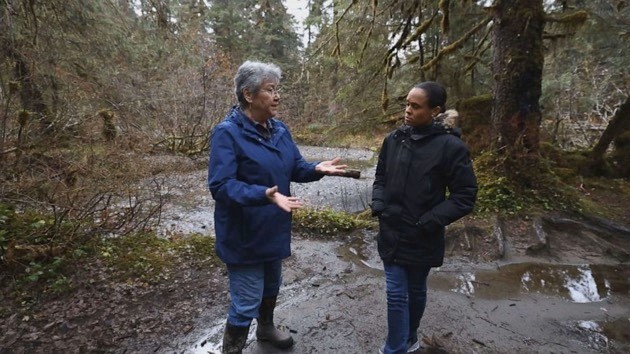
As of 11/12/2021, This Article was Cut and Pasted From:
https://www.myq104.com/2021/11/10/battle-rages-over-conservation-and-local-economy-in-alaska/
17 USC § 107 Limitations on Exclusive Rights – FAIR USE
Battle rages over conservation and local economy in Alaska
Campbellsville, KY, United States / Q 104.1 FM WCKQ
Lindsey Griswold, Seni Tienabeso, Linsey Davis and Haley Yamada, ABC News
Nov 10, 2021 | 6:50 AM

ABC News
(NEW YORK) — Tongass National Forest stretches across nearly 17 million acres of land in southeast Alaska and is home to a lush vibrant ecosystem. It is now also at the center of a bitter battle between those trying to save the old growth forests and those who say access more of it is critical for the local economy.
Tongass covers more than 80% of southeast Alaska and, according to the United States Department of Agriculture, is responsible for sequestering nearly 8% of all U.S. carbon emissions.
Global leaders have pledged for decades to end deforestation by 2030, but some Alaskan corporations are asking for the opposite and want more access to the forest to support the local economy.
“Where’s your Amazon boxes going to come from? American consumers still want this stuff. We’re producing it here. It’s a good job for us people, good jobs for Alaskans,” said Eric Nichols, the owner of Alcan Alaska Timber Corporation.
Southeast Alaska relies heavily on tourism, and took a major economic blow during the COVID-19 pandemic. Nichols, who said he’s had to downsize his company by half because of logging restrictions, said the timber industry is a way to bring consistent jobs back to the area.
“How do you raise a family on $15 an hour for a five-month job?” said Nichols. “How do I do that? I can’t do that. My kids can’t do that.”
Wanda Culp, a Tlingit native, is also worried about the future of this land and her family, but said that the natural forest is critical to their lifestyle. Her tribe has deep ties to the land.
“We depend on this wilderness as Indigenous people,” said Culp.
She noted that her people have used the forest as a natural resource for generations, but that the commercial “clearcutting” method of deforestation is disrespectful and unsustainable.
“We don’t just cut it down and let it land; we create a spot for it to land so it doesn’t split. So it’s worthwhile. That isn’t what happens with clear cuts. It’s total disrespect,” said Culp, who flew to Washington, D.C., in 2019 to protest large-scale deforestation in southeast Alaska.
In the late 1900s, the timber industry and forest clearcutting was prominent in southeast Alaska with nearly a million acres of the Tongass forest chopped down.
Bryce Dahlstrom of Viking Lumber supports clearcutting trees and likened it to any type of farming done across the country.
“It’s a crop that grows back,” said Dahlstrom. “If you don’t want a farmer to cut his corn down, don’t eat corn.”
In January 2001, just days before leaving office, President Bill Clinton enacted the Roadless Rule, which aims to preserve roadless areas by preventing road construction, as well as timber harvesting, on more than 9 million acres in the Tongass National Forest.
Since then, presidential administrations have gone back and forth on whether to keep or dismiss the rule, citing a variety of political reasons. For now, the rule remains in place.
Alaska Republican Gov. Mike Dunleavy has said between wood and minerals, there is untapped natural wealth in Alaska inhibited by the restriction.
“We’re the largest state in the country by far. This forest is larger than most states. There’s incredible opportunity to provide lumber and lumber products for the United States and possibly other parts of the world. This is an opportunity for us to do it here again and provide jobs, revenue and wealth,” said Dunleavy.
Many scientists say the health of the planet cannot be sacrificed for economic growth anymore, especially in places like Tongass, which are “carbon sinks” that help combat rising carbon emissions.
In 2020, 111 scientists from across the country wrote a letter to Biden asking him to permanently install protections in Tongass and create a strategic carbon reserve system.
Despite the restrictions from the Roadless Rule, Tongass is the last national forest that allows large-scale clearcut logging of ancient old-growth trees. Some argue it’s not an issue because trees can be replanted.
“[Trees] are a renewable resource. We cut trees down because there’s a demand for that product,” said Nichols.
But conservationist Meredith Trainor disagrees. She said the older the trees, the more effective they are at removing carbon dioxide and that an entire forest cannot be replaced so easily.
“There is no one tree scenario where we’re going to solve climate change, right? This is about managing a whole forest or a certain way,” said Trainor. “It’s the whole system that works together to sequester carbon and old growth is much more effective at doing that than young growth.”
The timber industry in southeast Alaska is only allowed to work in 2% of Tongass. Loggers like Nichols argue that’s not enough.
He wants to expand access even further, potentially giving loggers access to an additional half a million acres.
“I want enough to have an industry. We need about 5, maybe 6%, to continue to have a continuous industry up here,” said Nichols.
Scientists argue that the whole Alaskan ecosystem is connected. They believe that expanding the logging industry may have a negative effect on the region’s other largest employment sector: commercial fishing.
In Sitka, Alaska, an island town of about 8,000, they rely heavily on salmon fisheries. Fisherman Marsh Skeele said that the expansion of logging puts fishermen’s livelihoods at risk.
“[Logging] damages streams and lakes — freshwater ecosystems that salmon rely on, that fishermen rely on, that this community relies on,” said Skeele. “They’re kind of ignoring all the jobs that are tied to what exists already.”
Dunleavy said that it’s imperative to look at Alaska for all its potential and that doesn’t necessarily mean change is bad for the future of the state.
“There’s this narrative that’s trying to be pushed that if you touch Alaska, you will damage it permanently and ruin it. That’s not the case. It’s not the case at all,” said Dunleavy.
While some believe expanding access to Tongass National Forest could help more people than it could harm, a tug-of-war continues in southeast Alaska between the environment and the economy.
As for Culp, she said that the climate crisis is an issue that cannot be ignored any longer.
“We are in a serious, serious climate crisis. Why can’t we start repairing our habitat?” said Culp. “Why can’t we protect what we have? I want my great-granddaughter to be able to walk this land and breathe this fresh air, touch these trees, know who they are. It’s not much to ask.”


